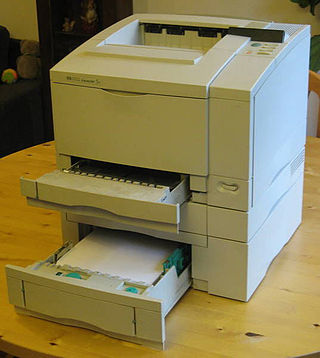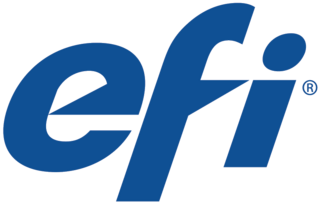
In computing, a printer is a peripheral machine which makes a persistent representation of graphics or text, usually on paper. While most output is human-readable, bar code printers are an example of an expanded use for printers. Different types of printers include 3D printers, inkjet printers, laser printers, and thermal printers.
In digital printing, a page description language (PDL) is a computer language that describes the appearance of a printed page in a higher level than an actual output bitmap. An overlapping term is printer control language, which includes Hewlett-Packard's Printer Command Language (PCL). PostScript is one of the most noted page description languages. The markup language adaptation of the PDL is the page description markup language.

A line printer prints one entire line of text before advancing to another line. Most early line printers were impact printers.

Dot matrix printing, sometimes called impact matrix printing, is a computer printing process in which ink is applied to a surface using a relatively low-resolution dot matrix for layout. Dot matrix printers typically use a print head that moves back and forth or in an up-and-down motion on the page and prints by impact, striking an ink-soaked cloth ribbon against the paper, much like the print mechanism on a typewriter or line printer. However, a dot matrix printer is able to print arbitrary patterns and not just specific characters.

Daisy wheel printing is an impact printing technology invented in 1970 by Andrew Gabor at Diablo Data Systems. It uses interchangeable pre-formed type elements, each with typically 96 glyphs, to generate high-quality output comparable to premium typewriters such as the IBM Selectric, but two to three times faster. Daisy wheel printing was used in electronic typewriters, word processors and computers from 1972. The daisy wheel is so named because of its resemblance to the daisy flower.
Centronics Data Computer Corporation was an American manufacturer of computer printers, now remembered primarily for the parallel interface that bears its name, the Centronics connector.
The IBM 6400 family of line matrix printers were modern highspeed business computer printers introduced by IBM in 1995. These printers were designed for use on a variety IBM systems including mainframes, servers, and PCs.

A dot matrix printer is an impact printer that prints using a fixed number of pins or wires. Typically the pins or wires are arranged in one or several vertical columns. The pins strike an ink-coated ribbon and force contact between the ribbon and the paper, so that each pin makes a small dot on the paper. The combination of these dots forms a dot matrix image. They were also known as serial dot matrix printers.
The TallyGenicom brand, acquired by Printronix in 2009, includes laser and line matrix printers, parts, consumables and service. Printronix now owns the intellectual property and worldwide sales distribution rights for TallyGenicom line matrix and laser technologies, including printers, supplies and consumables. TallyGenicom AG retained all intellectual property and worldwide distribution rights for the TallyGenicom serial matrix, inkjet and thermal technologies, including printers and options, supplies and consumables.

Zebra Technologies Corporation is an American mobile computing company specializing in technology used to sense, analyze, and act in real time. The company manufactures and sells marking, tracking, and computer printing technologies. Its products include mobile computers and tablets, software, thermal barcode label and receipt printers, RFID smart label printers/encoders/fixed & handheld readers/antennas, autonomous mobile robots (AMR’s) & machine vision (MV), and fixed industrial scanning hardware & software.

Tally was a leading American manufacturer of printers.
Intelligent Printer Data Stream (IPDS) is InfoPrint Solution Company's Systems Application Architecture host-to-printer data stream for Advanced Function Presentation subsystems. It provides an attachment-independent interface for controlling and managing all points addressable (APA) printers that allows the presentation of pages containing an architecturally unlimited mixture of different data types, including text, image, graphics, bar code and object container. It is used by a variety of InfoPrint and OEM print servers that drive all points addressable (APA) page printers. Generally these printers are at the medium to high end of the print speed and volume spectrum.
Canon Production Printing, formerly known as Océ until the end of 2019, is a Netherlands-based subset of Canon that develops, manufactures and sells printing and copying hardware and related software. The product line includes office printing and copying machinery, production printers, and wide-format printers for both technical documentation and color display graphics.

Continuous stationery (UK) or continuous form paper (US) is paper which is designed for use with dot-matrix and line printers with appropriate paper-feed mechanisms. Other names include fan-fold paper, sprocket-feed paper, burst paper, lineflow, tractor-feed paper, and pin-feed paper. It can be single-ply or multi-ply, often described as multipart stationery or forms. Continuous stationery is often used when the final print medium is less critical in terms of the appearance at the edges, and when continuously connected individual sheets are not inconvenient for the application. Individual sheets can be separated at the perforation, and sheets also have edges with punched holes, which also can be removed at the perforation.
Checkpoint Systems is an American company that specializes in loss prevention and merchandise visibility for retail companies. It makes products that allow retailers to check inventory, quicken the replenishment cycle, prevent out-of-stocks and reduce theft. Checkpoint offers Electronic Article Surveillance (EAS) radio frequency solutions for retail, high-theft and loss-prevention solutions, RFID hardware, software, and labeling capabilities.
Domino Printing Sciences PLC is a British-based developer of Industrial and Commercial inkjet printing, thermal transfer printing, print and apply machines, digital printing presses and laser printing products. At present, they are operating in over 120 countries and employ over 2,800 employees and have manufacturing facilities in the UK, US, China, Germany, India, Sweden and Switzerland. The company's roots are in the industrial printer hardware space, until recently, when they have begun to move into the software space.

Stratasys, Ltd. is an American-Israeli manufacturer of 3D printers, software, and materials for polymer additive manufacturing as well as 3D-printed parts on-demand. The company is incorporated in Israel. Engineers use Stratasys systems to model complex geometries in a wide range of polymer materials, including: ABS, polyphenylsulfone (PPSF), polycarbonate (PC) and polyetherimide and Nylon 12.

Electronics for Imaging, Inc. (EFI) is an international company based in Silicon Valley that specializes in digital printing technology. Formerly located in Foster City, California, the company is now based in Fremont. On July 1, 2015, EFI entered the textile printing marketing with the acquisition of Italian digital textile company Reggiani Macchine. On June 16, 2016, EFI acquired Optitex, a 3D digital workflow provider.

CYBRA Corporation is a software developer, publisher, and systems integrator in the IBM midrange market. CYBRA provides bar codes, RFID, and RTLS systems for IBM Power Systems and other server lines and other major computing platforms, bar code label and tag printing, and bar code scanning systems.
Lowry Solutions provides RFID services, barcode and wireless networking services, bar coding equipment, automatic label applicators, software, custom labels, ribbons and supplies.











